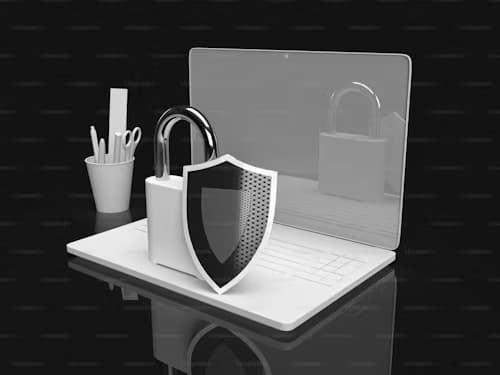
Cybersecurity for Small Businesses: Essential Strategies on a Budget
Introduction:
In today's digital landscape, small businesses are not immune to cyber threats. Despite limited resources, prioritizing cybersecurity is crucial to safeguarding sensitive data and maintaining customer trust. Let's delve into practical and budget-friendly cybersecurity strategies tailored for small businesses.
Understanding Small Business Cybersecurity
Small business cybersecurity encompasses a range of measures to protect against unauthorized access, data breaches, and other cyber threats. From securing network infrastructure to implementing robust authentication mechanisms, every aspect plays a vital role in fortifying your digital defenses.

Why do small businesses need cybersecurity?
68% of companies faced a cyber intrusion within the last year, according to Accenture's 2023 Cybersecurity Report. Human error contributed to 43% of data breaches. Additionally, just 38% of small enterprises feel adequately equipped to handle forthcoming cyber threats.
Statistical Overview:
A comprehensive overview of cybersecurity challenges faced by small businesses reveals alarming statistics. Notably, 46% of cyber breaches target companies with fewer than 1,000 employees, with 61% of SMBs falling victim to cyberattacks in 2021. Malware accounts for 18% of attacks against small businesses, while ransomware disproportionately targets companies with less than 1,000 employees, with 82% of such attacks directed at them. Among those affected by ransomware, 37% have fewer than 100 employees. Small businesses are bombarded with malicious emails, experiencing one targeted attack for every 323 emails received. Moreover, employees of small businesses face a staggering 350% increase in social engineering attacks compared to larger enterprises. Despite these risks, many small businesses lack adequate cybersecurity measures, with 51% having no security protocols in place and 47% allocating no budget to cybersecurity. Furthermore, only 17% have cyber insurance coverage, leaving 75% vulnerable to potential shutdown if hit by ransomware. With the average cost of cybersecurity incidents ranging from $826 to $653,587 and 29% of breached businesses responding by hiring cybersecurity experts, there is a pressing need for small businesses to prioritize cybersecurity measures such as encryption, multi-factor authentication, and the adoption of robust cybersecurity tools like antivirus software, firewalls, VPNs, and password management systems.
Cybersecurity Strategies for Small Businesses
Crafting effective cybersecurity strategies begins with understanding your business's unique risks and vulnerabilities. Start by conducting a thorough risk assessment to identify potential threats and prioritize areas for improvement. Implementing a multi-layered defense approach that includes network security, endpoint protection, and data encryption is essential.

1. Conducting a Thorough Risk Assessment
Before implementing any cybersecurity measures, it's essential to understand your business's specific risks and vulnerabilities. Conducting a comprehensive risk assessment involves identifying potential threats, assessing their likelihood and potential impact, and prioritizing areas for improvement. This process allows you to allocate resources effectively and focus on addressing the most critical security gaps.
2. Implementing a Multi-Layered Defense Approach
A multi-layered defense approach involves deploying multiple security measures at different levels of your IT infrastructure to create overlapping layers of protection. This approach is crucial for small businesses as it increases the complexity of attackers and reduces the likelihood of a successful breach. Key components of a multi-layered defense approach include:
Network Security:
Utilize firewalls, intrusion detection systems (IDS), and intrusion prevention systems (IPS) to oversee and regulate both inbound and outbound network traffic.
Secure your wireless networks with strong encryption protocols such as WPA2 or WPA3, and regularly update network devices with the latest security patches.

Endpoint Protection:
Install antivirus software and endpoint protection solutions on all devices connected to your network, including computers, laptops, smartphones, and tablets.
Enable endpoint detection and response (EDR) capabilities to detect and respond to advanced threats targeting endpoints.
Data Encryption:
Encrypt sensitive data both at rest and in transit to prevent unauthorized access in case of a data breach.
Utilize encryption technologies such as SSL/TLS for securing data transmission over the internet, and encryption algorithms like AES for protecting data stored on servers and devices.
3. Regular Security Updates and Patch Management
Keeping your software, applications, and systems up-to-date with the latest security patches is essential for mitigating known vulnerabilities and reducing the risk of exploitation by cyber attackers. Establish a patch management process to regularly review and apply security updates across your IT infrastructure, including operating systems, software applications, and firmware.

4. Employee Training and Awareness
Employees are often the weakest link in the cybersecurity chain, making ongoing training and awareness programs crucial for small businesses. Educate employees about common cyber threats such as phishing attacks, social engineering tactics, and malware infections. Provide training on how to recognize and report suspicious activity, and establish clear policies and procedures for handling sensitive information.
5. Incident Response Planning
Despite best efforts to prevent cyber attacks, no organization is immune to security incidents. Developing a robust incident response plan is essential for minimizing the impact of a breach and restoring normal operations quickly. Define roles and responsibilities, establish communication channels, and conduct regular incident response drills to ensure readiness in the event of a security incident.

Budget-Friendly Cybersecurity Solutions
Contrary to popular belief, cybersecurity doesn't have to break the bank. There are several budget-friendly solutions and practices that small businesses can adopt to enhance their security posture. From leveraging open-source security tools to investing in cloud-based security services, exploring cost-effective options is key.
Small Business Data Protection
Protecting sensitive business data is paramount for small businesses. Incorporate encryption protocols to safeguard data whether it's stored or being transmitted. Regularly back up critical data to prevent loss in the event of a cyber incident. Additionally, educate employees about the importance of data security and establish clear protocols for handling confidential information.

Cybersecurity Tips for SMBs
Stay updated on the most recent cybersecurity risks and developments. Educate employees on common cyber risks such as phishing attacks and social engineering tactics. Encourage the use of strong, unique passwords and enable multi-factor authentication wherever possible. Consistently keep software and systems up to date to address identified vulnerabilities through patches.
Affordable Cybersecurity Measures
Invest in affordable cybersecurity measures that provide maximum protection for minimal cost. Consider outsourcing certain security functions to managed security service providers (MSSPs) who can offer expertise and resources at a fraction of the cost of hiring dedicated security personnel.
Small Business Cyber Defense
Develop a robust cyber defense strategy that encompasses proactive measures such as threat intelligence gathering, security monitoring, and incident response planning. Establish clear protocols for responding to security incidents and breaches, including communication plans and recovery procedures.
SMB Cybersecurity Best Practices
Adopt industry best practices for small business cybersecurity, including regular security assessments, employee training programs, and compliance with relevant regulations such as GDPR and CCPA. Stay proactive and vigilant in identifying and mitigating potential security risks.
Secure Small Business Operations
Integrate cybersecurity into every aspect of your business operations, from IT infrastructure to employee workflows. Implement access controls and user permissions to limit the exposure of sensitive data. Monitor network traffic for suspicious activity and deploy intrusion detection systems to detect and respond to potential threats in real-time.
Conclusion
In conclusion, prioritizing cybersecurity is essential for small businesses to protect against evolving cyber threats and safeguard sensitive data. By implementing budget-friendly cybersecurity strategies and adopting best practices, small businesses can strengthen their digital defenses and mitigate the risk of cyber attacks. Remember, investing in cybersecurity is an investment in the long-term success and resilience of your business.
FAQs:
1. What are some budget-friendly cybersecurity solutions for small businesses?
Consider leveraging open-source security tools and cloud-based security services, which often offer cost-effective options.
Implementing multi-factor authentication (MFA) and encryption protocols can enhance security without significant financial investment.
Outsourcing certain security functions to managed security service providers (MSSPs) can provide expertise and resources at a fraction of the cost of hiring dedicated security personnel.
2. How can small businesses enhance their cybersecurity awareness?
Conduct regular cybersecurity training sessions for employees to educate them about common cyber threats and best practices.
Establish clear policies and procedures for handling sensitive data and responding to security incidents.
Encourage employees to stay informed about the latest cybersecurity trends and to report any suspicious activity promptly.
3. What steps can small businesses take to improve their data protection measures?
Implement robust encryption protocols to secure data both at rest and in transit.
Regularly back up critical data to prevent loss in the event of a cyber incident.
Limit access to sensitive data through the use of access controls and user permissions, and monitor network traffic for any unusual activity.